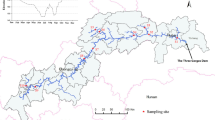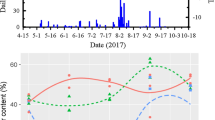Abstract
Tussock swamp meadow, as a typical wetland in Northeast China, is governed by hydrological variations. Understanding the responses of tussocks to environment factors would help in advancing the management, protection and restoration of tussock sedge wetlands. We investigated ecological characteristics of tussocks in coverage, species height and above-biomass along a flooding gradient. Tussock patterning and hummock size were also recorded to identify the mechanisms of self-organization in tussock swamp meadow. Results showed that sampling sites and species had no significant effects on tussock ecological characteristics. Species coverage, species height and biomass were moderately related to flooding depth. The fittings based on Gauss model showed that the optimum flooding depth and flooding proportion for tussock biomass in critical growth period are 11.2 cm and 29.6%, respectively. Species coverage and above-biomass increased with increasing tussock density. Relationships between above-biomass and hummock size accorded with Gauss curve. Linear mixed-effect models indicated that flooding proportion, tussock density and hummock height exert great influences on the growth of tussocks. Results help to advance our understanding of the tussocks’ responses to environmental factors and the mechanisms of self-organization in tussock sedge wetlands.




Similar content being viewed by others
REFERENCES
Mitsch, W.J. and Gosselink, J.G, Wetlands, New York: Wiley, 2007.
Zhang, L., Zhang G.X., Li, H., et al., Eco-physiological responses of Scirpus planiculmis to different water-salt conditions in Momoge wetland, Pol. J. Environ. Stud., 2014, vol. 23, no. 5, pp. 1813–1820.
Lou, Y., Pan, Y., Gao, C., et al., Response of plant height, species richness and aboveground biomass to flooding gradient along vegetation zones in floodplain wetlands, Northeast China, PLoS One, 2016, vol. 11, no. 4, e0153972.
Tsuyuzaki, S. and Tsujii, T., Size and shape of Carex meyeriana tussocks in an alpine wetland, northern Sichuan Province, China, Can. J. Bot., 1992, vol. 70, no. 11, pp. 2310–2312.
Wang, M., Wang, G., Wang, S., et al., Structure and richness of Carex meyeriana tussocks in peatlands of Northeastern China, Wetlands, 2017, vol. 38, no. 1, pp. 15–23.
Ramirez, D.A., Valladares, F., Domingo, F., et al., Seasonal water-use efficiency and chlorophyll fluorescence response in alpha grass (Stipa tenacissima L.) is affected by tussock size, Photosynthetica, 2008, vol. 46, no. 2, pp. 222–231.
Levine, J.M., Local interactions, dispersal, and native and exotic plant diversity along a California stream, Oikos, 2001, vol. 95, no. 3, pp. 397–408.
Crain, C.M. and Bertness, N.D., Community impacts of a tussock sedge: Is ecosystem engineering important in benign habitats?, Ecology, 2005, vol. 86, no. 10, pp. 2695–2704.
Yi, F.K., Wetland Wild Vascular Plants in Northeast China, Beijing: Science Press, 2008.
Costello, D.F., Tussock meadows in southeastern Wisconsin, Bot. Gazette, 1936, vol. 97, pp. 610–648.
Peach, M. and Zedler, J.B, How tussocks structure sedge meadow vegetation, Wetlands, 2006, vol. 26, no. 2, pp. 322–335.
Lawrence, B.A. and Zedler, J.B., Formation of tussocks by sedges: Effects of hydroperiod and nutrients, Ecol. Appl., 2011, vol. 21, no. 5, pp. 1745–1759.
van De-Koppel, J. and Crain, C.M., Scale-dependent inhibition drives regular tussock spacing in a freshwater marsh, Am. Nat., 2006, vol. 168, no. 5, pp. E136–E147.
Wang, Y., Feng, J., Lin, Q., et al., Effects of crude oil contamination on soil physical and chemical properties in Momoge Wetland of China, Chin. Geogr. Sci., 2013, vol. 23, no. 6, pp. 708–715.
Wang, X., Zhang, D., Qi, Q., et al., The restoration feasibility of degraded Carex tussock in soda-salinization area in arid region. Ecol. Indic., 2019, vol. 98, pp. 131–136.
Pan, X., Zhang, D., and Liu, Q., Interactive factors leading to dying-off Carex tato in Momoge wetland polluted by crude oil, Western Jilin, China, Chemosphere, 2006, vol. 65, no. 10, pp. 1772–1777.
Zhao, K.Y., Mires in China, Beijing: Science Press, 1999.
Liu, Y., Jiang, M., Lu, X., et al., Carbon, nitrogen and phosphorus contents of wetland soils in relation to environment factors in Northeast China, Wetlands, 2017, vol. 37, no. 1, pp. 153–161.
Cui, B.S., He, Q., and Zhao, X.S., Ecological thresholds of Suaeda salsa to the environmental gradients of water table depth and soil salinity, Acta Ecol. Sinica, 2008, vol. 28, no. 4, pp. 1408–1418.
Keddy, P. and Fraser L.H., Four general principles for the management and conservation of wetlands in large lakes: The role of water levels, nutrients, competitive hierarchies and centrifugal organization, Lakes Reserv. Res. Manag., 2000, vol. 5, pp. 177–185.
Wang, H.Y., Chen, J.K., and Zhou, J., Influence of water level gradient on plant growth, reproduction and biomass allocation of wetland plant species, Acta Phytoccol. Sinica, 1999, vol. 23, no. 3, pp. 269–274.
Zhang, D.J., Qi, Q., Tong, S.Z., et al., Effect of alternative dry–wet shiftinging on eco-physiological characteristics of Carex schmidtii tussocks, Chin. J. Ecol., 2018, vol. 37, no. 1, pp. 43–49.
Bornette, G. and Puijalon, S., Response of aquatic plants to abiotic factors: A review, Aquat. Sci., 2011, vol. 73, no. 1, pp. 1–14.
Yuan, J.H., Wang, P., Weiner, J., et al., The effects of soil drying on the growth of a dominant peatland species, Carex lasiocarpa,Wetlands, 2017, vol. 37, no. 6, pp. 1–9.
Chen, X.S., Li, Y.F., Xie, Y.H., et al., Trade-off between allocation to reproductive ramets and rhizome buds in Carex brevicuspis populations along a small-scale elevational gradient, Sci. Rep., 2015, vol. 5, article no. 12688.
Yan, H., Liu, R.Q., Liu, Z.N., et al., Growth and physiological responses to water depths in Carex schmidtii Meinsh, PLoS One, 2015, vol. 10, no. 5, e0128176.
Zhang, X.H., Mao, R., Gong, C., et al., Effects of hydrology and competition on plant growth in a freshwater marsh of northeast China, J. Freshw. Ecol., 2014, vol. 29, no. 1, pp. 117–128.
Jiang, H.B., Wen, Y., Zou, L.F., et al., The effects of a wetland restoration project on the Siberian crane (Grus leucogeranus) population and stopover habitat in Momoge National Nature Reserve, China, Ecol. Eng., 2016, vol. 96, pp. 170–177.
Zhang, D., Qi, Q., Wang, X., et al., Physiological responses of Carex schmidtii Meinsh to alternating flooding–drought conditions in the Momoge wetland, northeast China, Aquat. Bot., 2019, vol. 153, pp. 33–39.
Guo, J., Jiang, H.B., Bian, H.F., et al., Effects of hydrologic mediation and plantation of Carex schmidtii Meinsh. on peatland restoration in China’s Changbai Mountain region, Ecol. Eng., 2016, vol. 96, pp. 187–193.
Borkowska, L., Lembic, M., and Kasprzkowski, Z., A non-soil seed bank dependent on the size of clonal plants: the case of Carex cespitosa, a guerrilla species in an unmown meadow, Pol. J. Ecol., 2017, vol. 65, no. 2, pp. 258–268.
Milotic, T. and Hoffmann, M., The impact of dung on inter- and intraspecific competition of temperate grassland seeds, J. Veget. Sci., 2017, vol. 28, pp. 774–786.
ACKNOWLEDGMENTS
This research was supported by the Science and Technology Development Project of Jilin Province (no. 20190201115JC), the National Natural Science Foundation of China (no. 41871101) and the National Key R&D Program of China (no. 2016YFC0500403). “We gratefully acknowledge financial support to Zhang Dongjie from the China Scholarship Council.”
Author information
Authors and Affiliations
Corresponding authors
Rights and permissions
About this article
Cite this article
Zhang, D.J., Qi, Q. & Tong, S.Z. Growth of Carex Tussocks as a Response of Flooding Depth and Tussock Patterning and Size in Temperate Sedge Wetland, Northeast China. Russ J Ecol 51, 144–150 (2020). https://doi.org/10.1134/S1067413620020137
Received:
Revised:
Accepted:
Published:
Issue Date:
DOI: https://doi.org/10.1134/S1067413620020137




